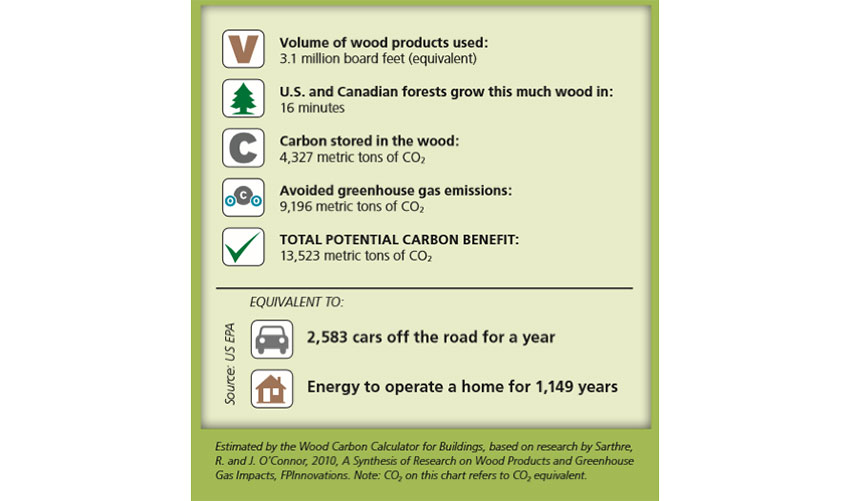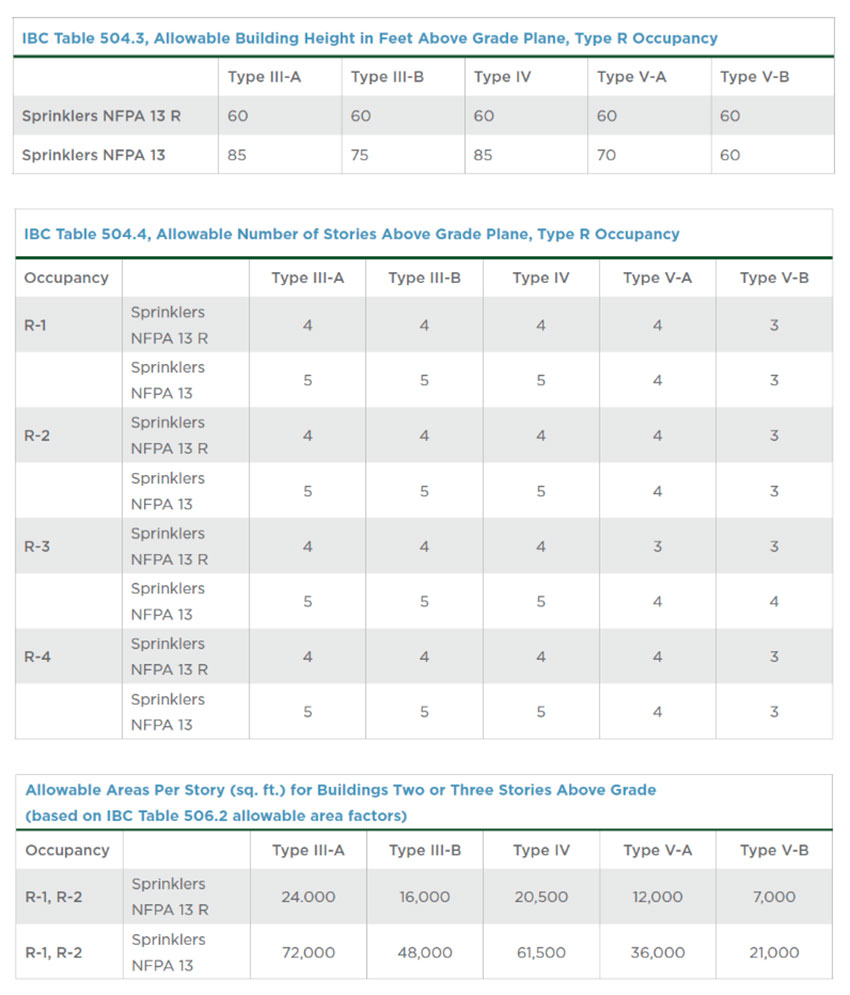Multi-Family, Mid-Rise Wood Buildings A Code-Compliant, Cost-Effective and Sustainable Choice
 1 AIA LU/HSW; 1 IDCEC CEU/HSW; 1 GBCI CE Hour; 0.1 ICC CEU; 0.1 IACET CEU*; 1 AIBD P-CE; AAA 1 Structured Learning Hour; This course can be self-reported to the AANB, as per their CE Guidelines; AAPEI 1 Structured Learning Hour; This course can be self-reported to the AIBC, as per their CE Guidelines.; MAA 1 Structured Learning Hour; This course can be self-reported to the NLAA.; This course can be self-reported to the NSAA; NWTAA 1 Structured Learning Hour; OAA 1 Learning Hour; SAA 1 Hour of Core Learning
1 AIA LU/HSW; 1 IDCEC CEU/HSW; 1 GBCI CE Hour; 0.1 ICC CEU; 0.1 IACET CEU*; 1 AIBD P-CE; AAA 1 Structured Learning Hour; This course can be self-reported to the AANB, as per their CE Guidelines; AAPEI 1 Structured Learning Hour; This course can be self-reported to the AIBC, as per their CE Guidelines.; MAA 1 Structured Learning Hour; This course can be self-reported to the NLAA.; This course can be self-reported to the NSAA; NWTAA 1 Structured Learning Hour; OAA 1 Learning Hour; SAA 1 Hour of Core Learning
Learning Objectives:
- Identify the sustainability and economic benefits of using wood construction for mid-rise multi-family or mixed-use buildings.
- Summarize building code requirements and provisions for mid-rise multi-family wood-frame structures.
- Discuss wood framing solutions that address issues such as shrinkage, fire protection and seismic requirements while minimizing the carbon footprint of the building.
- Explore innovations in wood framing design techniques and wood product technologies that enhance energy efficiency.
This course is part of the Mass Timber Academy
Sustainability
Wood construction offers advantages for project teams seeking green building certification or simply interested in reducing the environmental impact of their buildings. Wood grows naturally and is renewable, and life cycle assessment studies show that wood offers environmental advantages in terms of embodied energy, air pollution, water pollution, and other impact indicators.5
From a carbon footprint perspective, wood continues to store carbon absorbed during the tree’s growing cycle, keeping it out of the atmosphere for the lifetime of the building—or longer if the wood is reclaimed at the end of the building’s service life and reused or manufactured into other products. The manufacturing of wood products also results in less greenhouse gas emissions than other materials.6
The Berkshire Terminus development in Atlanta is one such example. The property includes three buildings, each with five stories of wood-frame construction over a concrete podium. The online Wood Carbon Calculator for Buildings7 shows that the project’s wood construction has contributed to storing and avoiding 13,523 metric tons of CO2, equivalent to the annual emissions from 2,583 cars.
In terms of long-term durability and life cycle, a 2004 survey of 227 buildings demolished in Minneapolis/St. Paul found that buildings are often torn down within 50 years.8 This was true regardless of the construction materials used. It was not due to material performance issues, but was instead due to changing occupation needs and increasing land values. Overall, wood buildings in the study had the longest life spans, showing that wood structural systems are capable of meeting a building’s longevity expectations. In addition, when the embodied energy in demolished buildings is considered along with the implications of material disposal, it is clear that longer lasting buildings are more sustainable. Further, the fact that wood can be reused at the end of its service life in a building, either through renovation or deconstruction and reuse (with minimal additional processing), is also a significant advantage.

The Building Code And Wood Construction
As with any type of construction, mastering the technical details of wood-frame construction is critical to creating cost-effective buildings that are durable, safe, and code compliant. Building codes require all building systems to perform to the same level of safety, regardless of material used, and wood-frame structures can be designed to meet or exceed standards for fire protection, seismic performance, and resistance to high winds.
The International Building Code (IBC) is a model building code developed by the International Code Council (ICC). It is the predominant model building code in the United States, having been adopted by most jurisdictions with or without amendments. It is reviewed and/or amended over a three-year cycle, with the 2021 edition being the current version.
Construction Types
Chapter 6 of the IBC categorizes buildings into five distinct types of construction. With the exception of Type IV, each construction type is further subdivided into A and B subtypes, with A indicating higher fire-resistance ratings than B. Wood framing is permitted in some aspects of all five.
- Construction Types I and II are generally limited to noncombustible materials such as concrete and steel for structural and some nonstructural items. Wood may be used in nonbearing walls and partitions that do not require a fire-resistance rating. In addition, fire retardant-treated (FRT) wood is permitted in nonbearing partitions, with a required fire rating of no more than 2 hours, in nonbearing exterior walls that are not required to be fire rated, and in most roof construction.
- Type III is defined as noncombustible exterior walls and interior walls of any material allowed by code. Fire retardant-treated (FRT) wood framing is allowed for exterior wall assemblies of a 2-hour rating or less.
- Type IV, also known as Heavy Timber (HT), also requires noncombustible exterior walls. However, exterior walls of a 2-hour rating or less can be FRT wood, or cross-laminated timber that is protected with gypsum, FRT wood, or a noncombustible material. Interior building elements are defined as made from solid or laminated wood of minimum dimensions, and without concealed spaces. The IBC elaborates on different types of solid and laminated wood products and requirements for each.
- Type V allows structural elements, exterior walls, and interior walls to be constructed of any material allowed by code, including common wood-framing systems.
The 2021 IBC includes three new construction types, Type IV-A, IV-B, and IV-C, which allows the expanded use of mass timber. The new construction types are based on the previous Heavy Timber construction type (renamed Type IV-HT) but with additional fire-resistance ratings and levels of required noncombustible protection. The code includes provisions for up to 18 stories of Type IV-A construction for business and residential occupancies, paving the way for increased use of mass timber for multifamily construction.
Permissible Increases in Area and Height
The allowable height and area of a building is determined by construction type, the level of passive fire resistance provided to the structure, and by the intended occupancy. Chapter 5 of the IBC addresses General Building Heights and Areas. There are several considerations here for construction Types III, IV, and V, which are the most common building types for multifamily construction:
- Allowable heights are determined based on occupancy classification and construction type, as shown in Table 504.3, Allowable Building Height in Feet Above Grade Plane. Multifamily buildings (Group R occupancy) are required to be protected by an automatic sprinkler system in accordance with IBC Section 903.2.8. Therefore, new multifamily buildings with sprinklers can be up to 60 feet tall if the sprinkler system is installed in accordance with NFPA Standard 13R. If a sprinkler system is installed per the broader NFPA Standard 13 requirements, then the allowable height can be increased up to 85 feet tall, depending on construction type.
- Number of stories is treated separately from building height, meaning that both must meet compliance requirements. The code limits the number of stories above the grade plane based on occupancy and construction type, per Table 504.4. This means that multifamily R-1, R-2, R-3, and R-4 occupancies may be limited to five stories, depending on construction type and sprinkler system type. For example, an R-2 apartment building with an NFPA 13R sprinkler system with Type III or IV construction is limited to four stories. If the sprinkler system is changed to a general NFPA 13 system, they are allowed to go up to five stories.
- Mezzanines are not considered stories under the building code. Rather, they are defined as intermediate levels between the floor and ceiling of a story and are considered to be part of the story below the mezzanine. Mezzanines can be inserted into stories if their floor area falls within code area limits and the total allowable building height is not exceeded. Effective use of mezzanines can increase the return on investment for a developer. For example, the extra half-story mezzanine for Marselle, a 160,000-square-foot condominium complex in Seattle, added about $250,000 to the cost of the building. But the extra space and views it provided to units on the top floor increased the value of the complex by $1 million.9
- Allowable floor areas are based on occupancy, sprinkler type, and construction type. For multifamily projects, that allowable area can vary widely based on these factors. For example, an R-2 apartment building with an NFPA 13R sprinkler system and Type V-B construction is limited to 7,000 square feet per story, up to three stories (assuming no increases for open frontage), which may be fine for some situations. If larger floor areas are sought, then switching to a standard NFPA 13 system would allow an increase to 21,000 square feet per story, whereas changing to Type V-A construction would only allow up to 12,000 square feet per story. Keeping the NFPA 13R sprinklers and going to Type IV (HT) construction would increase the allowable area up to 20,500 square feet; going to Type III-B would allow 16,000 square feet; Type III-A would allow 24,000 square feet per story. But switching to the standard NFPA 13 sprinkler system would triple each of those allowable per-story areas for two- and three-story buildings, and quadruple them for single-story buildings. Additionally, Types III and IV construction can be five stories as opposed to four. Total building floor area for these buildings is limited to what would be permitted for a three-story building.

Fire Protection Requirements
Regardless of material used, all buildings, including multifamily structures, must be designed to protect the health, safety, and welfare of occupants and first responders. When proper fire protection systems are designed into a wood-framed structure, the dangers associated with fire are mitigated. The code recognizes that there are different ways to accomplish this and requires that design professionals demonstrate that required levels of fire protection are provided. The minimum fire-resistance rating requirements for building elements (i.e. structure, walls, floor, roof, etc.), based on construction type are provided in IBC Table 601. Specific details of fire- and smoke-protection features are detailed in Chapter 7. The building code’s intent is that the combination of fire resistance and active protective systems provides containment of a fire within a defined space (such as an apartment) so that building occupants have time to evacuate before the fire can move to other parts of the building.

Based on these requirements, wood-frame building elements, just like other materials that require fire-resistance ratings, typically show compliance per independent test procedures. Two common testing standards are ASTM E119, Standard Test Methods for Fire Tests of Building Construction Materials, and UL 263, Fire Tests of Building Construction and Materials. The code also provides alternative methods for determining fire resistance per IBC Section 703.3, which includes prescriptive fire resistance as shown in tables in Section 721 and other approved sources, calculated fire resistance as provided in Section 722, and engineering analyses based on comparisons of tested assemblies or building elements.











